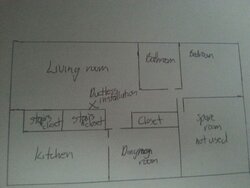Hello. I had a 18000 hyper heat mini split installed this past fall in my living room. I am very impressed as my electric bill has been so much cheaper. What I need help on is adding some more heat to the rest of the house when its in the low teens and below and to give the 18000 unit some help during defrosts and so maybe help the cop. My house has all electric radiant heat until that addition except the basement which has no heat and has quite a bit of moisture from no heat. Temps in the basement can get down to 42 ish and it mostly underground. i thought of a few options and looking to see what would be the best. I attached a rough drawing of the main floor to give an idea and where the current unit is at. I sized the 18000 unit due to being the hardest to heat and the extra heat for the negative temps. AC is not an issue since the house is cool in the summer. Location is south west pa.
First is just put a hyper heat or fugitsu .75 ton unit in either the spare bedroom to push heat out to the back of the house though I'm not sure if its worth doing since the bathroom and bedroom are not bad . I use a box fan to push the air out of it to the living room. Or I could put it in the dining room to push the air to the kitchen where it was chilly. The unit could be either a floor or mounted near the floor on the opposite wall of the kitchen walkway. Other idea though I don't think it would help the main floor is mount it in the basement. These units have around a 13.5 hspf.
Next option is do a 20000 hyperheat dual mutizone unit. If I do that I would have to decide which one of the three areas don't get one. 10 hspf
Last option is a 24000 hyper heat tri unit. I could heat all those areas buts its going to probaley cost $1500 more I really don't think its worth it. 10 hspf
Any ideas would be welcome. I also don't have natural gas or ductwork in the house. House and insulated really good but need to replace a few windows eventually that are older but double pane.
First is just put a hyper heat or fugitsu .75 ton unit in either the spare bedroom to push heat out to the back of the house though I'm not sure if its worth doing since the bathroom and bedroom are not bad . I use a box fan to push the air out of it to the living room. Or I could put it in the dining room to push the air to the kitchen where it was chilly. The unit could be either a floor or mounted near the floor on the opposite wall of the kitchen walkway. Other idea though I don't think it would help the main floor is mount it in the basement. These units have around a 13.5 hspf.
Next option is do a 20000 hyperheat dual mutizone unit. If I do that I would have to decide which one of the three areas don't get one. 10 hspf
Last option is a 24000 hyper heat tri unit. I could heat all those areas buts its going to probaley cost $1500 more I really don't think its worth it. 10 hspf
Any ideas would be welcome. I also don't have natural gas or ductwork in the house. House and insulated really good but need to replace a few windows eventually that are older but double pane.



